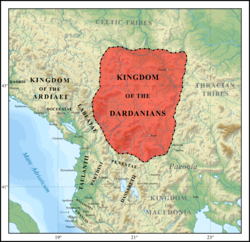
Back مملكة داردانيا Arabic Dardània (Il·líria) Catalan Βασίλειο της Δαρδανίας Greek Dardaania Kuningriik Estonian Dardania (Moesia) Finnish Kerajaan Dardania ID Koninkrijk Dardanië Dutch Kraljevina Dardanija Serbo-Croatian Mbretëria e Dardanisë Albanian Краљевина Дарданија Serbian
Kingdom of Dardania Regnum Dardaniae | |||||||
|---|---|---|---|---|---|---|---|
| 4th century BC–28 BC | |||||||
 | |||||||
| Religion | Dardanian Polytheism | ||||||
| Demonym(s) | Dardanian, Dardani | ||||||
| Government | Monarchy | ||||||
| King | |||||||
• c. 231 – c. 206 BC | Longarus | ||||||
• c. 206 BC – c. 176 BC | Bato | ||||||
• c. 176 – c. 167 BC | Monunius | ||||||
| Historical era | Classical antiquity | ||||||
• Founded | 4th century BC | ||||||
• Roman conquest | 28 BC | ||||||
| Area | |||||||
• Total | 56,000 km2 (22,000 sq mi) | ||||||
| |||||||
| Today part of | |||||||
The Kingdom of Dardania (Latin: Regnum Dardaniae) was a polity in the central Balkans in the region of Dardania during classical antiquity. It is named after the Dardani, a Paleo-Balkan tribe that formed the core of the Dardanian polity. Dardania was centered around present-day Kosovo, but also included parts of North Macedonia (northwestern area), Serbia (Novi Pazar) and Albania (Kukës, Tropoja, Has).[1] The eastern parts of Dardania were at the Thraco-Illyrian contact zone. Marcus Licinius Crassus, grandson of the triumvir Marcus Crassus, officially annexed the kingdom in 28 BC while on campaign against the Dacians and Bastarnae.[2] The region was subsequently incorporated into the province of Moesia in 15 BC, and later in 293 AD, as the province of Dardania.
- ^ Shukriu, Edi (2008). "Prehistory and Antique History of Kosova" (PDF). Thesis Kosova. 1: 11–12. Archived from the original (PDF) on 2022-10-13. Retrieved 2022-07-16.
- ^ Petrović 2007, p. 10.